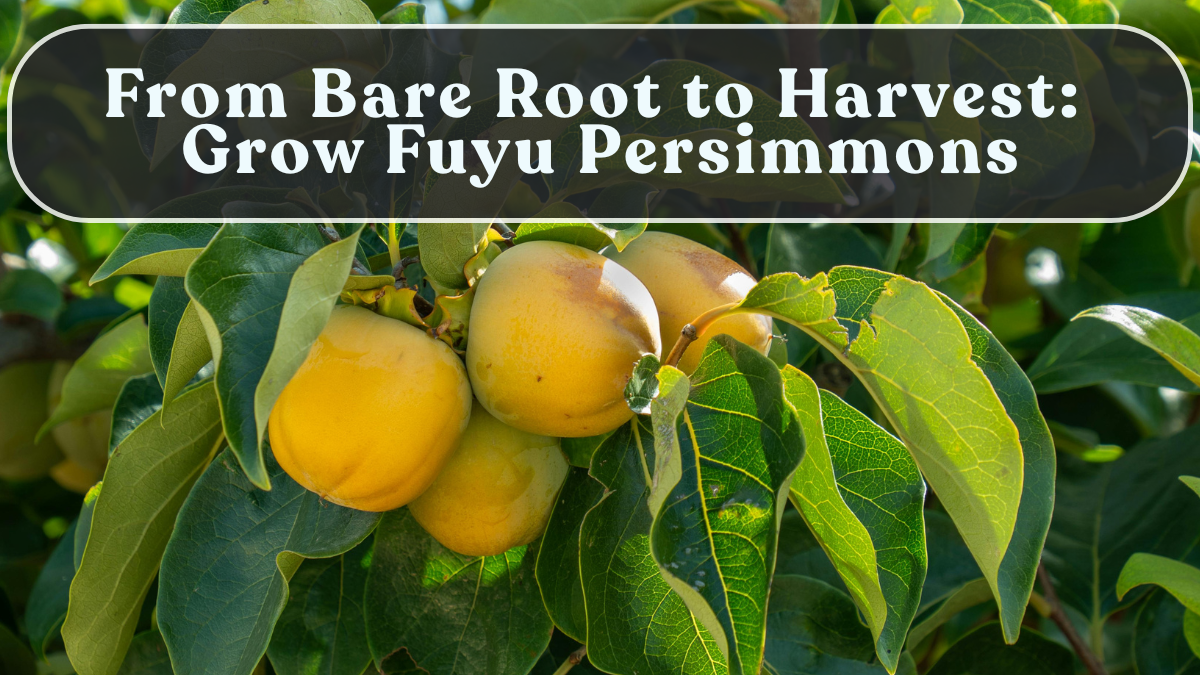The Fuyu Persimmon is one of the sweetest and most popular non-astringent persimmon varieties, perfect for both eating fresh and drying. Known for its crisp, honey-flavored fruit and attractive orange color, it’s a great addition to any home garden. Growing Fuyu persimmons from bare-root trees is not only simple but also rewarding once the tree starts bearing heavy yields of fruit every fall.
Here’s everything you need to know—from planting to harvesting your first batch of delicious persimmons.

About the Fuyu Persimmon
The Fuyu variety originated in Japan and is prized for its crunchy texture and mild sweetness. Unlike other persimmons, Fuyu can be eaten while still firm, without the astringent taste caused by tannins. The fruits are medium to large in size and beautifully glossy orange when ripe.
A mature tree can grow up to 15–20 feet tall, bearing fruit for decades with minimal maintenance. It’s ideal for warm, subtropical, and Mediterranean climates.
Bare Root Planting Guide
Bare root planting is the most cost-effective and efficient way to grow persimmons. Follow these steps:
-
Timing: Plant your bare root tree in late winter or early spring, before new growth begins.
-
Soil Preparation: Choose well-drained loamy soil and mix in organic compost or manure.
-
Planting Hole: Dig a 2×2 foot hole wide enough for the roots to spread comfortably.
-
Planting Depth: Place the tree so that the graft union sits just above ground level.
-
Watering: Fill the hole halfway with soil, water thoroughly, then finish filling and water again.
Mulch around the base to retain moisture and suppress weeds, but keep the mulch 2–3 inches away from the trunk to prevent rot.
Sunlight and Water Requirements
Fuyu persimmons thrive in full sunlight, needing at least 6–8 hours of direct sun daily. They prefer moderate watering—keep the soil consistently moist during the first two years, but once established, the tree becomes drought-tolerant.
During fruiting, reduce watering slightly to enhance the sweetness of the fruit. Always ensure good drainage; persimmons dislike standing water.
Training and Pruning
To build a strong structure and promote heavy fruiting:
-
In the first year, train a central leader with 3–4 strong side branches.
-
In later years, prune annually during late winter to remove crossing or dead branches.
-
Thin crowded branches to allow sunlight and airflow, preventing fungal diseases.
Pruning also helps maintain a manageable tree height, making harvesting easier.
Fertilizing for Healthy Growth
Feed your tree once in spring and again in midsummer. Use a balanced organic fertilizer or compost enriched with potassium and phosphorus for better fruit set. Avoid high-nitrogen fertilizers—they cause leafy growth at the expense of fruiting.
Adding bone meal or wood ash improves calcium and fruit quality. Mulch regularly to preserve soil nutrients.
Flowering and Fruiting
Fuyu persimmons begin flowering in 3–4 years after planting. Small, cream-colored flowers appear in late spring and attract pollinators like bees. Most Fuyu trees are self-pollinating, so a single tree can produce a good harvest.
Fruit matures in October to December, turning deep orange and firm. Harvest when the fruit is fully colored and slightly soft when pressed.
Pests and Diseases
Fuyu persimmons are relatively hardy but can occasionally face pests like aphids, fruit flies, and mealybugs.
-
Use neem oil or soap spray once every two weeks during growing season.
-
Ensure proper pruning to avoid fungal problems like leaf spot or mildew.
-
Keep the base clean of fallen fruits to prevent pest buildup.
Harvesting and Storage
Harvest persimmons by cutting them off with pruning shears, leaving a short stem attached. Handle carefully to avoid bruising.
Store firm fruits at room temperature to ripen naturally, or refrigerate ripe ones for up to 2 weeks. You can also dry them in the sun for chewy, sweet snacks that last months.
Conclusion
Growing Fuyu persimmons from bare-root trees is a delightful way to add both beauty and sweetness to your garden. With simple pruning, consistent watering, and organic feeding, your tree will reward you with heavy yields of golden-orange fruit year after year.
A well-cared-for Fuyu tree is not just a fruit source—it’s a symbol of patience and abundance, bringing the taste of autumn right to your backyard.
FAQs
How long does it take for Fuyu persimmons to bear fruit?
They usually start fruiting in 3–4 years after planting from a bare root.
Do Fuyu persimmons need another tree to pollinate?
No, Fuyu persimmons are self-pollinating, so one tree is enough.
When is the best time to plant a bare-root persimmon?
In late winter or early spring, before new growth starts.
How often should I water my persimmon tree?
Water weekly during the first two years, then reduce frequency once it’s established.
Can I grow Fuyu persimmons in pots?
Yes, choose a large 24-inch pot, provide full sunlight, and prune regularly to control size.
